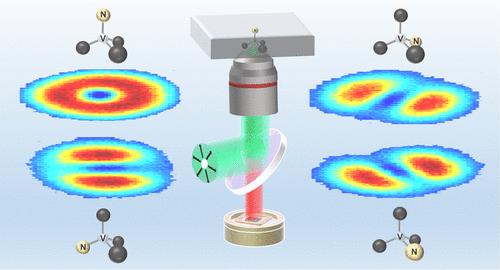Visualized Axial Localization of Nitrogen-Vacancy Center in Bulk Diamond Assisted by Radially Polarized Beam
IF 6.7
1区 物理与天体物理
Q1 MATERIALS SCIENCE, MULTIDISCIPLINARY
引用次数: 0
Abstract
Nitrogen-vacancy (NV) centers in bulk diamond, as an excellent spin-based vector quantum sensor, require precise determination of the axis orientation information. Here, we efficiently visualize and completely determine the NV axis orientation in bulk diamond, assisted by a radially polarized beam. We observe the rotational asymmetric fluorescence pattern of NV centers in bulk diamond, which is quite different from that in nanodiamonds. Our theoretical calculations show this difference is mainly due to the fact that the ratio between the longitudinal and transverse electric field components of the focused radially polarized beam is greatly weakened in bulk diamond. This fluorescence pattern asymmetry can uniquely determine both the azimuth angle and the polar angle without degeneracy in bulk diamond. Then, we verify these theories in bulk diamond with different orientations and nanodiamonds. The experimental result is consistent with that of the traditional method by measuring a series of optically detected magnetic resonance (ODMR) spectra, and the error is less than 3.0 degrees. Our method can be easily extended to other solid-state spin systems and shows great potential in quantum sensing of vector magnetic fields and nanoscale dynamic processes.

径向偏振光束辅助下块状金刚石中氮空位中心的可视化轴向定位
块状金刚石中的氮空位(NV)中心作为一种出色的自旋矢量量子传感器,需要精确测定轴方向信息。在这里,我们在径向偏振光束的帮助下,有效地观察并完全确定了块状金刚石中的氮空位轴方向。我们观察到大块金刚石中 NV 中心的旋转不对称荧光模式,这与纳米金刚石中的模式截然不同。我们的理论计算表明,这种差异主要是由于在大块金刚石中,聚焦的径向偏振光束的纵向和横向电场分量之间的比率大大减弱。在块状金刚石中,这种荧光图案的不对称性可以唯一地确定方位角和极角,而不会出现退化现象。然后,我们在不同取向的块状金刚石和纳米金刚石中验证了这些理论。通过测量一系列光学检测磁共振(ODMR)光谱,实验结果与传统方法一致,误差小于 3.0 度。我们的方法可以很容易地扩展到其他固态自旋系统,在矢量磁场和纳米级动态过程的量子传感方面显示出巨大的潜力。
本文章由计算机程序翻译,如有差异,请以英文原文为准。
求助全文
约1分钟内获得全文
求助全文
来源期刊

ACS Photonics
NANOSCIENCE & NANOTECHNOLOGY-MATERIALS SCIENCE, MULTIDISCIPLINARY
CiteScore
11.90
自引率
5.70%
发文量
438
审稿时长
2.3 months
期刊介绍:
Published as soon as accepted and summarized in monthly issues, ACS Photonics will publish Research Articles, Letters, Perspectives, and Reviews, to encompass the full scope of published research in this field.
 求助内容:
求助内容: 应助结果提醒方式:
应助结果提醒方式:


